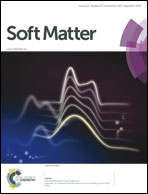Amphiphilic interactions of ionic liquids with lipid biomembranes: a molecular simulation study†
Abstract
Current bottlenecks in the large-scale commercial use of many ionic liquids (ILs) include their high costs, low biodegradability, and often unknown toxicities. As a proactive effort to better understand the molecular mechanisms of ionic liquid toxicities, the work herein presents a comprehensive molecular simulation study on the interactions of 1-n-alkyl-3-methylimidazolium-based ILs with a phosphatidylcholine (PC) lipid bilayer. We explore the effects of increasing alkyl chain length (n = 4, 8, and 12) in the cation and anion hydrophobicity on the interactions with the lipid bilayer. Bulk atomistic molecular dynamics (MD) simulations performed at millimolar (mM) IL concentrations show spontaneous insertion of cations into the lipid bilayer regardless of the alkyl chain length and a favorable orientational preference once a cation is inserted. Cations also exhibit the ability to “flip” inside the lipid bilayer (as is common for amphiphiles) if partially inserted with an unfavorable orientation. Moreover, structural analysis of the lipid bilayer show that cationic insertion induces roughening of the bilayer surface, which may be a precursor to bilayer disruption. To overcome the limitation in the timescale of our simulations, free energies for a single IL cation and anion insertion have been determined based on potential of mean force calculations. These results show a decrease in free energy in response to both short and long alkyl chain IL cation insertion, and likewise for a single hydrophobic anion insertion, but an increase in free energy for the insertion of a hydrophilic chloride anion. Both bulk MD simulations and free energy calculations suggest that toxicity mechanisms toward biological systems are likely caused by ILs behaving as ionic surfactants. [Yoo et al., Soft Matter, 2014].


 Please wait while we load your content...
Please wait while we load your content...